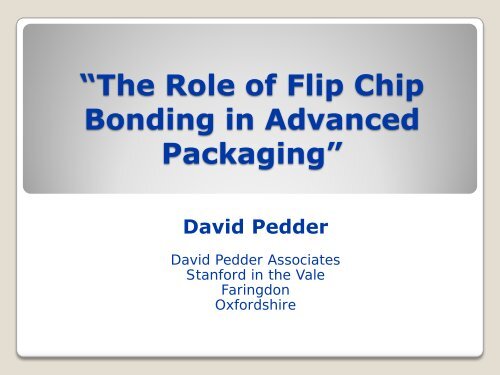The Role of Flip Chip
The Role of Flip Chip
The Role of Flip Chip
You also want an ePaper? Increase the reach of your titles
YUMPU automatically turns print PDFs into web optimized ePapers that Google loves.
“<strong>The</strong> <strong>Role</strong> <strong>of</strong> <strong>Flip</strong> <strong>Chip</strong><br />
Bonding in Advanced<br />
Packaging”<br />
David Pedder<br />
David Pedder Associates<br />
Stanford in the Vale<br />
Faringdon<br />
Oxfordshire
“<strong>The</strong> <strong>Role</strong> <strong>of</strong> <strong>Flip</strong> <strong>Chip</strong> Bonding in Advanced<br />
Packaging”<br />
Outline<br />
<strong>Flip</strong> <strong>Chip</strong> Definitions<br />
<strong>Flip</strong> <strong>Chip</strong> Technologies<br />
<strong>Flip</strong> <strong>Chip</strong> Properties<br />
<strong>Flip</strong> <strong>Chip</strong> Applications<br />
<strong>Flip</strong> <strong>Chip</strong> – <strong>The</strong> Future<br />
Summary & Conclusions
<strong>Flip</strong> <strong>Chip</strong> Definitions *<br />
<strong>Flip</strong> “ A mixture <strong>of</strong> beer & spirits<br />
sweetened with sugar and heated<br />
with a hot iron”<br />
<strong>Chip</strong> “ A counter used in games <strong>of</strong> chance”<br />
Bond “ in a state <strong>of</strong> serfdom or slavery”<br />
or …..<br />
* Shorter Oxford English Dictionary, Vol. 1, 1970
<strong>Flip</strong> <strong>Chip</strong> Definitions *<br />
• <strong>Flip</strong> <strong>Chip</strong> Bonding - <strong>The</strong> connection <strong>of</strong> a device,<br />
bond pads face down, onto a substrate with a<br />
matching array <strong>of</strong> bond pads
<strong>Flip</strong> chip bonding history<br />
• 1960<br />
– IBM develops Solid Logic Technology<br />
• 1964<br />
– Totta and Miller develop the C4 process<br />
– C4 = Controlled Collapse <strong>Chip</strong> Connection<br />
IBM<br />
Corporation<br />
IBM Corporation
<strong>Flip</strong> chip bonding evolution<br />
• 3 bonds/chip 1964 Cu ball transistor<br />
• 10-30 bonds/chip 1970 C4 SSIC<br />
• 120 bonds/chip 1980 C4 LSI<br />
• 354 bonds/chip 1985 C4 VLSI<br />
• 2100 bonds/chip 2000 C4 SoC
<strong>Flip</strong> chip bonding advantages<br />
• Very high interconnection density<br />
Area array and peripheral bonds possible<br />
Fine pitch (50m) connections possible<br />
Improved high frequency/speed<br />
performance<br />
Short/repeatable connection length<br />
Reduced electrical parasitics<br />
Minimal component footprint<br />
True chip scale package<br />
Pac Tech GmbH<br />
National Semiconductor Corp
<strong>Flip</strong> chip bonding technologies<br />
• Solder flip chip<br />
• Adhesive flip chip<br />
• Solid phase flip chip
Solder flip chip bonding<br />
• Common uses<br />
<strong>Flip</strong> chip on board (FCOB)<br />
<strong>Flip</strong> chip in package (FCIP)<br />
System in package (SiP)<br />
Hybrid modules<br />
• Solder advantages<br />
Self aligning (
As deposited<br />
oxide<br />
Solder flip chip bonding<br />
Bumping<br />
reflowed<br />
Pb<br />
CrCu/CuSn<br />
AlSi<br />
Device<br />
passivation<br />
• Controlled dewetting<br />
• CrCuAu wettable metal<br />
• 95Pb5Sn solder<br />
Bonding<br />
Device<br />
Substrate<br />
• Limited wettable areas<br />
• Surface tension controlled<br />
alignment<br />
stand-<strong>of</strong>f
Solder flip chip bond design<br />
mg/n<br />
S p.A<br />
S<br />
Substrate<br />
• Balance <strong>of</strong> surface tension & gravitational forces<br />
• Conservation <strong>of</strong> volume allows joint design<br />
• Surface tension dominates<br />
• Double truncated sphere approximation<br />
• Sets solder uniformity requirements, mixed bond design
Solder flip chip bond design<br />
= 0 o = 180 o<br />
• Solder volume uniformity requirements<br />
Perimeter volume
Solder flip chip bond design<br />
As deposited<br />
reflowed<br />
bonded<br />
125<br />
70<br />
33.5<br />
20.8<br />
13.3<br />
6.9<br />
3.0<br />
• Matched 18 & 70 m bond design<br />
43<br />
18<br />
23.8
Solder flip chip bond alignment<br />
• Solder vernier structure<br />
• Alignment < 2m vernier resolution
Solder bumping<br />
• Wafer level processing<br />
• Under bump metallisation (UBM)<br />
Ohmic contact<br />
Adhesion/barrier between the pad and the bump<br />
Wettable surface<br />
• Common UBM deposition techniques<br />
Plating<br />
Evaporation<br />
Sputtering<br />
• Typical UBMs<br />
Ni/Au<br />
Cr/CrCu/Cu/Au<br />
NiV/Cu<br />
TiW<br />
IC Interconnect
Solder bumping<br />
• Typical solder alloys<br />
High melting point Lead/Tin (95/5) solder<br />
Eutectic Tin/Lead (63/37) solder<br />
Lead-free solder: Tin/Copper/Silver etc<br />
Eutectic Gold/Tin (80/20) solder<br />
• Common solder deposition techniques<br />
Evaporation<br />
Plating<br />
Stencil printing<br />
Laser dispense<br />
Mould transfer<br />
IC Interconnect
Solder bumping underfill<br />
• Required for flip chip on board (FCOB) reliability<br />
• Underfill process<br />
underfill dispense<br />
underfill cure<br />
Dispense needle<br />
<strong>Flip</strong> <strong>Chip</strong> Integrated Circuit<br />
Laminate Printed Circuit Board<br />
Underfill drawn<br />
under die by capillary<br />
action
h<br />
Solder bumping reliability<br />
<br />
• Low cycle thermal fatigue<br />
d<br />
Si<br />
substrate<br />
solder<br />
• Factors<br />
Cycle amplitude<br />
<strong>Chip</strong> size<br />
CTE mismatch<br />
Solder alloy<br />
Bond geometry<br />
Use <strong>of</strong> underfill
Adhesive flip chip bonding<br />
• Common uses<br />
<strong>Chip</strong> on glass (COG)<br />
<strong>Chip</strong> on flex (COF)<br />
• Adhesive advantages<br />
Fine pitch (50µm)<br />
Low temperature process<br />
No separate underfill required (Anisotropic Conductive Adhesive)<br />
Lead-free
Adhesive flip chip wafer bumping<br />
• Wafer level processing<br />
• Common bump deposition techniques<br />
Gold stud bumps formed with a gold ball bonder<br />
Electroless plated nickel bumps/thin immersion gold<br />
Electrolytic plated gold bumps, typically on a TiW UBM<br />
Polymer bumps (selectively placed conducting adhesive)<br />
Hesse & Knipps<br />
Citizen Watch Co., Ltd.
Adhesive flip chip bonding<br />
Anisotropic<br />
Conductive Film<br />
(conductive particles<br />
in a non-conductive<br />
adhesive)<br />
Heated pick-up<br />
tool<br />
Integrated Circuit Die<br />
Substrate
Adhesive flip chip bonding
Solid phase flip chip bonding<br />
• Common uses<br />
<strong>Flip</strong> chip on board (FCOB)<br />
<strong>Flip</strong> chip in package (FCIP)<br />
System in package (SIP)<br />
Hybrid modules<br />
• Die pads require bumping<br />
Gold stud bumps<br />
Electroplated gold bumps<br />
Hesse & Knipps
Solid phase bonding processes<br />
Heat, compression<br />
Heat, compression,<br />
ultrasonic vibration<br />
<strong>The</strong>rmocompression <strong>The</strong>rmosonic<br />
Hesse & Knipps<br />
Hesse & Knipps
Solid phase bump coining<br />
Individual/gang coining
Solder flip chip bond properties<br />
Bonding Parameter Wire Bond TAB <strong>Flip</strong> <strong>Chip</strong><br />
Material(s) Al Au Cu Pb-Sn<br />
Melting temperature, o C 660 1064 1084 310 or 183<br />
Typical bond geometry 25m diameter 25x100m tape x 100m diameter<br />
x 2.5mm length 2.5mm length 80m height<br />
Typical pitch, m 100m perimeter 200m perimeter 200m area<br />
Bond strength, grams 6 10 50 20<br />
Bond resistance, m.ohms 142 122 17 1.2<br />
Interbond capacitance, pF 0.025 0.025 0.006 0.001<br />
Bond inductance, nH 2.6 2.6 2.1
<strong>Flip</strong> chip industry infrastructure<br />
• Wafer bumping<br />
Over 20 companies established<br />
• <strong>Flip</strong> chip substrates<br />
~ 20 companies established<br />
• <strong>Flip</strong> chip equipment<br />
Over 20 manufacturers established<br />
• <strong>Flip</strong> chip assembly services<br />
Over 30 subcontractors<br />
Tyco Electronics
<strong>Flip</strong> chip applications<br />
• Silicon devices<br />
Discretes<br />
RFICs - SiGe<br />
ASICs, Microprocessors & System-on-<strong>Chip</strong><br />
• GaAs devices<br />
• Integrated Passive Devices (IPDs)<br />
• System-in-Package (SiPs)<br />
• 3D Integration<br />
• Photonics Assemblies<br />
device and substrate alignment<br />
spatial light modulator<br />
• Sensors<br />
Uncooled, cooled IR sensors<br />
HDD readers
<strong>Flip</strong> chip discretes<br />
Source: National Semiconductor.
<strong>Flip</strong> chip on lead<br />
SOT23 MLP<br />
Source: Carsem.
<strong>Flip</strong> chip RFIC<br />
Bluetooth Radio Module<br />
RF IC: 46 flip chip bonds at 200m pitch<br />
Thin film integrated passives substrate<br />
40 BGA balls at 0.80mm pitch<br />
Source: Intarsia.
<strong>Flip</strong> chip CPU IC<br />
Pentium II chip : 2100 flip chip bonds at 250m pitch<br />
BGA substrate<br />
570 BGA balls at 1.27mm pitch<br />
mini-cartridge substrate<br />
240 way connector<br />
Source: Intel
Source:GMMT<br />
<strong>Flip</strong> chip GaAs
Source:CMD<br />
<strong>Flip</strong> chip IPDs<br />
Source: Telephus
<strong>Flip</strong> chip SiPs<br />
Source: Intarsia. Source: STMicroelectronics
20<br />
18<br />
16<br />
14<br />
12<br />
10<br />
8<br />
6<br />
4<br />
2<br />
0<br />
bare<br />
die<br />
<strong>Flip</strong> chip SiP utilisation<br />
SiP technologies - die level<br />
CSP Other 2D 3D wire<br />
bond<br />
flip<br />
chip<br />
solder<br />
ball<br />
die packaging die placement die interconnection<br />
Source: eKTN<br />
TSV
<strong>Flip</strong> chip 3D integration<br />
Source: iNEMI, IMEC
<strong>Flip</strong> chip 3D integration<br />
Source: iNEMI, Renesas
16Gb<br />
memory<br />
(8 x 2Gb)<br />
560μm<br />
<strong>Flip</strong> chip 3D integration<br />
TSV<br />
Micro<br />
bump<br />
50μm thick <strong>Chip</strong><br />
Laser<br />
drilled<br />
via<br />
Source: iNEMI, Samsung
Source: GMMT<br />
<strong>Flip</strong> chip photonics devices
<strong>Flip</strong> chip IR sensor devices<br />
Source: Irisys
<strong>Flip</strong> chip hard disc sensor devices<br />
Source: Seagate
<strong>Flip</strong> <strong>Chip</strong> Trends<br />
Much wider uptake<br />
2% to 10% all devices<br />
IPDs & high I/O devices<br />
Growth <strong>of</strong> infrastructure<br />
New technologies<br />
Cu pillar bumping<br />
Lower cost processes<br />
Finer pitch<br />
<strong>Chip</strong>-to-chip bonding<br />
Improved reliability<br />
<strong>Flip</strong> <strong>Chip</strong> Bonding<br />
Source: TechSearch International, Inc.<br />
Source: <strong>Chip</strong>Works
<strong>Flip</strong> <strong>Chip</strong> Futures<br />
• <strong>Flip</strong> chip usage will continue to grow<br />
• Drivers<br />
High I/O applications<br />
Where size is critical<br />
High frequency/speed applications<br />
IPDs, SiPs, 3D integration<br />
<strong>Flip</strong> <strong>Chip</strong> Bonding
Thank you for your attention<br />
David Pedder<br />
David Pedder Associates<br />
18, Ock Meadow, Stanford in the Vale<br />
Faringdon, Oxfordshire SN7 8LN<br />
DJPedderDPA@aol.com<br />
+44 (0)1367 718420<br />
+44 (0)7899 952230
















